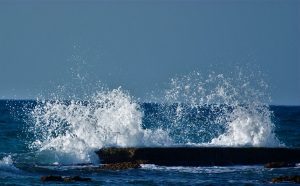The city of Haifa is the third-largest one in Israel after Jerusalem and Tel Aviv. It consists of the Haifa metropolitan area that hosts the third most populated area of Israel. One of the notable landmarks of Haifa is the Baháʼí Faith’s Baháʼí World Centre, which is a UNESCO World Heritage Site and a destination for Baháʼí pilgrimage. Haifa lies on the slopes of Mount Carmel, and its history dates back to three thousand years ago. Indeed, the ancient history of Haifa started in the Late Bronze Age, in the 14th century BCE, when a settlement was founded in the area was under the name of Tell Abu Hawam, and it was a small port city. Haifa became a dye-making centre in the third century CE. Throughout the several millennia, the Haifa area had been surmounted and governed by many conquerors such as Arabs, Byzantines, British, Canaanites, Crusaders, Hasmoneans, Israelites, Ottomans, Persians, Phoenicians, and Romans. Starting from 1948, when the State of Israel was established, the Haifa Municipality governed the city. Since 2016, Haifa has become one of the major seaports in the Mediterranean area and the main in Israel, extending over almost 64 square kilometres. The Port of Haifa lies 90 kilometres north of Tel Aviv, and it is the most prominent centre of north Israel.

Moreover, in Haifa, there are two of the best academic institutions of Israel: the University of Haifa and the Technion, i.e. Israel Institute of Technology, which is the oldest and top-ranked Israeli university in the Middle East. Both these academic institutions are located in Haifa as well as the Hebrew Reali School, which is the largest K–12 school in Israel (the term K–12 includes schools from kindergarten to 12th grade, and it is an American expression indicating the years of publicly supported primary and secondary education of the United States). Additionally, Haifa is an important economic pole of Israel, and it houses the Matam, which is one of the oldest and biggest high-tech parks in Israel. Another peculiarity of Haifa is that it hosts the only underground rapid transit system in Israel that is known under the name of Carmelit. The Haifa Bay is the Israeli centre of heavy industry, with chemical processing and petroleum refining. In the beginning, Haifa was the western terminus of an oil pipeline starting in Iraq and crossing Jordan.
Historical names and locations of Haifa
The name of Haifa could come from the high priest Caiaphas, and some Christians assume that the name could be due to Saint Peter, whose Aramaic name was Keiphah. There is another assumption that the name Haifa could descend from the Hebrew verb root חפה-hafa that means “to cover or shield” because Mount Carmel protects Haifa. Another hypothesis could lead to the Hebrew word חוֹף-hof, which means “shore”, and also חוֹף יָפֶה-hof yafe, meaning “beautiful shore”.
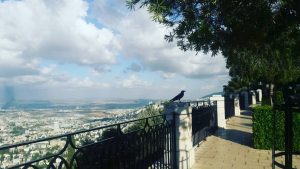
The most ancient settlement in the area of Haifa was Sycaminum, whose archaeological remnants have been discovered in a coastal archaeological mound, Tel Shikmona, which means “mound of the Ficus sycomorus”.
During the Roman domination, after the first century, a fortress and a small Jewish settlement were built close to Tel Shikmona. Haifa is a very well-known city, and it is also cited more than 100 times in the Talmud, an important book in Judaism. Another name of Sycaminus was Hefa or Hepha in the Onomasticon, Eusebius of Caesarea’s 4th-century work. Moshe Sharon explained that the twin ancient settlements, Haifa-Sycaminon, slowly became twin towns under the name of Sycaminon or Sycaminos Polis until the Byzantine period. In the 6th century, Porphyreon or Porphyrea was mentioned in some writing of William of Tyre, and it was a settlement in the south of Haifa-Sycaminon. In the 7th century, after the Arab conquest, Haifa became a site lying above the ruins of Sycaminon. Haifa or Haifah is cited in 11th-century Persian chronicles and in 12th and 13th-century Arab historical records, where Haifa is described as a town lying on the seashore with many palm gardens, trees and shipbuilders who were building huge ships. In the 12th-century, the Crusaders seized Haifa, calling it Caiphas. It might be that the name could be related to Cephas, the Aramaic name of Simon Peter, Eusebius mentioned Hega as Caiaphas civitas, and Benjamin of Tudela, a 12th-century historian and traveller, attributed the establishment of the city to Caiaphas, i.e. the Jewish high priest in the period of Jesus. In the late Ottoman period, Haifa’s name was Haifa al-‘Atiqa, which means “Ancient Haifa” in Arabic. It was another name adopted by some inhabitants to name Tell es-Samak when Haifa was a hamlet of 250 residents. Between 1764 and 1765, Zahir al-Umar al-Zaydani, an autonomous Arab ruler of northern Palestine in the mid-18th century, transferred the village to a new location at 2.4 kilometres to the east. The new town was the nucleus of modern Haifa. In the beginning, it was named al-Imara al-Jadida, which means “the new construction” in Arabic, and also Haifa al-Jadida, which means “New Haifa” in Arabic, and then, with the time, the city was called Haifa. At the beginning of the 20th-century, Haifa al’ Atiqa was reinhabited by several Arab Christians in a neighbourhood where many Middle Eastern Jews had settled previously; hereafter, Haifa extended outside of its new position.
Historical chronicles of the city of Haifa
The Bronze Age and the Hebrew Bible
In the Late Bronze Age, in the 14th-century BCE, the city of Haifa was established under the name of Tell Abu Hawam, and it was a fishing village and port. In the Hebrew Bible, there are mentions about the Kishon River and Mount Carmel. A cave on the top of Mount Carmel is well-known as the “Cave of Elijah”, traditionally associated with the Prophet Elijah and Elisha’s student. Muhraka is the highest peak of the Carmel mountain range, which means “place of burning” in Arabic, recalling the burnt offerings and sacrifices that took place there in the Canaanite and early Israelite periods.
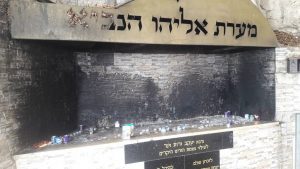
The Persian and Hellenistic eras
During the Persian domination, in the 6th century BCE, Scylax, a Greek geographer, wrote about a city lying “between the bay and the Promontory of Zeus”, the Carmel, which could refer to Shikmona, a place in the Haifa area. During the Hellenistic times, the city moved to a southern location where the modern Haifa neighbourhood of Bat Galim is located because the old harbour was obstructed with sand. In this period, a Greek-speaking community lived near the coast, being involved in trade and commerce. Haifa was settled close to the town of Shikmona, a centre of the production of the traditional Tekhelet dye that was employed in the garments of the high priests in the Temple. The archaeological site of Shikmona is located southwest of Bat Galim. The initial town of Haifa might have been in the area extending from Rambam Hospital up to the Jewish Cemetery on Yafo Street. Initially, the inhabitants were engaged in the business of fishing and agriculture.
The Roman period
In the third century CE, Haifa was mentioned in the Talmud as a village devoted to fishing and the Torah centre of Rabbi Avdimi with his scholars, who of the greatest amoraim of Israel (the amoraim were Jewish Oral Torah scholars in the period between the 200 and the 500 CE). In the Talmud, there is a description of the fishing activities in Haifa, such as catching Murex and sea snails whose purple dye was used to make tallit (Jewish prayer shawls). Among the tombs dating back to the Roman period, Jewish burial caves have been discovered.
The Byzantine period
During the Byzantine domination, Haifa expanded, but its role did not become critical. A kinah, i.e. a Jewish lamentation, refers to the destruction of the Haifa Jewish community and other communities during the country’s conquest by the hands of the Byzantines in the Byzantine-Sasanian War.
The Early Arab period
Between the 630s and 640s, the Arabs conquered Palestine, but Akko was the favourite port city instead of Haifa. Nevertheless, during the Rashidun Caliphate, Haifa was reflourished, and in the 9th century, Haifa became a trading centre under the Umayyad and Abbasid Caliphates. Indeed, there were trading relations with Egyptian ports, and in Haifa, many shipyards became more present in its big harbour. The residents were both Arabs and Jews, and they were engaged in maritime trade and commerce. Moreover, the most lucrative businesses of the city of Haifa were glass production and dye-making from marine snails.
The Crusader and the Sultanate
The luxury and prosperity of Haifa finished in 1100 during the besiegement of Haifa at the hands of the European Christians after the end of the First Crusade, when the Jewish inhabitants of Haifa were the majority of the city’s population. Under the siege of the Crusaders, Haifa became a small coastal secure fortress, and it was part of the Principality of Galilee in the Kingdom of Jerusalem. In 1187, during the Battle of Hattin, Saladin’s Ayyubid’s armies conquered Haifa destroying the Crusader’s fortress. Nevertheless, in 1191, the Crusaders reconquered Haifa under the reign of Richard the Lionheart.
In the 12th century, the caves of Mount Carmel were the dwellings of religious hermits. In the 13th century, they created the new Catholic monastic order of the Carmelites, building the Carmelite monastery on Mount Carmel. However, under Muslim domination, the monastery was transformed into a mosque and later into a hospital.
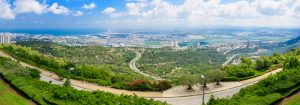
In the 19th century, the Carmelite monastery went restored, and it became the Stella Maris Monastery. The altar of the monastery’s church lies above the cave associated with the Prophet Elijah.
In 1265, the Mamluk sultan Baibars’s armies seized Haifa, and they destroyed all the fortifications that successively had been rebuilt again by King Louis IX of France. The sultan’s troops also destroyed most of the houses to halt the return of the European Crusaders. Starting from the period of the Mamluks’ conquest until the 15th century, Haifa remained a small unfortified village that stayed barely inhabited with the time. Few Jews were living there, and both Jews and Christians were going on pilgrimage to the Cave of Elijah on Mount Carmel.
In the 14th century, during the Mamluk dominion, Haifa had the function of a port for Tiberias, being a discrete harbour suitable for the anchorage of galleys and other ships.
The Ottoman domination
In 1516, Haifa was uninhabited when the Ottoman Empire conquered the entire country. In 1596, Haifa had a population of 32 Muslim households paying taxes on barley, beehives, goats, olives, summer crops and wheat. Nevertheless, Haifa was a half-ruined poor village with still few residents. In the 17th century, Haifa was reflourished as a trade centre due to the expansion of commercial trade between Europe and Palestine. Hence, in the port of Haifa, there were more docking ships than in Acre. In 1742, Haifa became a small village with a Jewish community consisting of immigrants from Morocco and Algeria with a synagogue. And between 1764 and 1765, there were 250 inhabitants, and Haifa was situated in Tell el-Semak, the ancient Sycaminum. In 1769, the Arab ruler of Acre and Galilee was Zahir al-Umar. He transferred the new town of Haifa to a new fortified location, which is in the actual area of the city, and this represented the beginning of the modern city of Haifa. From 1775 until 1918, Haifa remained under the dominion of the Ottoman empire except in two short periods. In 1799, Napoleon Bonaparte seized Haifa, but soon he was forced to withdraw, even though he ordered to erect fortifications in Haifa and Acre, Jaffa and Gaza.
Between 1831 and 1840, Muhammad Ali was the Egyptian ruler who governed Haifa after his son Ibrahim Pasha conquered the city, defeating the Ottomans. At the end of the Egyptian occupation, Acre collapsed, and the importance of Haifa increased. In 1858, the girdled city of Haifa was overpopulated, and it started the reconstruction of houses outside the city walls on the slopes of Mount Carmel. In 1859, Haifa’s population was around 3,000 inhabitants, and even though the majority of the population consisted of Muslims, there was still a tiny Jewish community. In 1798, Rabbi Nachman of Breslov celebrated Rosh HaShana with the Jewish community of Haifa. In 1839 the Jewish population counted 124 people, and in the same period, Haifa’s Christian population grew because of the increasing importance of the Carmelite monks. In 1840 almost 40% of Haifa’s inhabitants were Christian Arabs.
In 1868 the German messianic and Templars settled in the German Colony, representing an important event in Haifa’s evolution. The Templars built a steam-based power station and opened factories besides inaugurating carriage services to Acre, Nazareth and Tiberias, contributing a lot to modernize the city. The first significant wave of Jewish immigration occurred in the mid-19th century, most of them were from Morocco, and a minority came from Turkey successively. In the 1870s, most Jewish and Arab immigrants settled in Haifa, improving the town’s prosperity. Jews formed one-eighth of Haifa’s population, and the majority of them was from Morocco and Turkey, inhabiting the Jewish Quarter, situated in the eastern part of the town. With the time, Jewish immigration steadily increased the Haifa Jewish population, including a small number of Ashkenazi families, who opened hotels for the new Jewish immigrants in Haifa. In 1875, the Jewish community of Haifa counted about 200 members. Starting from the late 19th century, the Jewish immigrants were coming mainly from Eastern Europe. In the 1880s, many Jewish immigrants from Romania resided in Haifa, and the Central Jewish Colonisation Society in Romania acquired more than 4.0 square kilometres close to Haifa. At the beginning of World War I, the Jewish population increased to 3,000 inhabitants.
In 1909, Haifa became very important to the Baháʼí Faith because the remains of the Báb, founder of the Bábí Faith, were moved from Acre to Haifa and buried in the shrine erected on Mount Carmel. Baháʼís venerate the shrine as their second holiest place on Earth after the Shrine of Baháʼu’lláh in Acre.

In the first part of the 20th century, Haifa developed as an industrial port city with an increasing population. The Jezreel Valley railway was built between 1903 and 1905, and it increased the amount of commerce of Haifa, drawing foreign merchants and artisans. Between 1912 and 1924, the Technion Institute of Technology was built as a Jewish technical institution that later became one of Israel’s and worldwide’s best universities. The Jewish community of Haifa founded many factories and cultural institutions.
The British Mandate period
In 1918, Haifa was seized by Indian horsemen of the British Army who defeated the Ottomans, and the British troops heading to Nazareth had as a consequence the withdrawal of Turks from Haifa. Below the British Mandate, Haifa underwent through a large-scale expansion, becoming an industrial port city. Haifa has been the spiritual and administrative centre of the Baháʼí Faith religious group. Haifa became an immigration centre for many Jewish newcomers. The port was a vital fount of economic progress, and in the 1930s, the close Jewish boroughs of the Krayot were built.
Meanwhile, the Arab population also increased because of the many migrants coming from the neighbouring villages and the Syrian Hauran.
In 1931, Haifa had a population consisting of 20,324 Muslims, 15,923 Jews, and 13,824 Christians. And in 1938, in Haifa, there were 52,000 Jews and 51,000 Muslims and Christians. The economic development of Haifa was mainly due to the British plans to improve the centrality of the port as a hub for Middle-East petroleum, building refineries, determining the city’s fast development as the Israel centre of the heavy industries. Moreover, Haifa became one of the first towns to be electrified entirely when the Palestine Electric Company inaugurated the Haifa Electrical Power Station in 1925. This event involved the start of Haifa’s industrialization.
Moreover, the State-run Palestine Railways built its main workshops in Haifa likewise. And in 1947, Haifa’s population consisted of about 70,910 Arabs (29,910 Christians and 41,000 Muslims) and 74,230 Jews. The Christian community of Haifa were mostly Greek-Melkite Catholics.
The 1947-1949 Israel’s War of Independence
The War of Independence that occurred in Israel between 1947 and 1949 involved the death of more than 6,000 Israelis and 15,000 wounded. Israel proclaimed its independence at the end of the War of Independence in January 1949, which occurred because of the rejection of the United Nation’s Partition Plan by the Arab states and the Palestinian Arab Higher Committee. On 14 May 1948, David Ben-Gurion read out the Declaration of the Establishment of the State of Israel, i.e. Israel’s Declaration of Independence, in a ceremony that took place at Beit Dizengoff in Tel Aviv, signing it with other members of the Provisional State Council. The document incorporates a summary of the Jewish people’s history, the Jewish struggle to regain their birthright in Israel with international recognition, and a declaration of the jurisdiction that will guide the State of Israel. Haifa became the Jewish immigration centre, and during the 1948 Arab–Israeli War, the neighbourhoods of Haifa became disputed between the two factions.
After the war, Jewish immigrants resided in the new neighbourhoods of Haifa, such as Kiryat Eliezer, Kiryat Hayim, Ramot Remez, Ramat Shaul, and Kiryat Sprinzak. In this period, Bnei Zion Hospital and the Central Synagogue were built. In 1953, a proposal regarding transportations and future architectural arrangements was drafted. Starting from the 1960s, Tel Aviv achieved a better status than Haifa that suffered a decline in its role as a regional capital, and the opening of Ashdod’s port intensified this situation. Nevertheless, Haifa’s population counted 200,000 inhabitants at the beginning of the 1970s, and the mass immigration from the former Soviet Union raised the number of residents to an additional 35,000 people. The Matam high-tech park that has been the first dedicated high-tech park in Israel, was inaugurated in Haifa in the 1970s. Several historical Ottoman buildings have been demolished, and in the 1990s, most parts of the Old City were destroyed to renew the municipal centre. Between 1999 and 2003, several Palestinian suicide attacks occurred in Haifa, killing 68 civilians, and in 2006, Haifa was attacked by 93 Hezbollah rockets during the Second Lebanon War, with the consequent death of 11 civilians; hence, half of the city’s population fled away.
Demography of Haifa
Nowadays, Haifa is Israel’s third-largest city, consisting of 103,000 households, which corresponds to a population of almost 290,000 residents. The 25% of Haifa’s population consists of immigrants from the former Soviet Union; therefore, Russian is one of the three main languages of Haifa. Israeli Arabs compose 10% of Haifa’s population, and the majority live in Abbas, Halissa, and Wadi Nisnas neighbourhoods. Haifa is usually depicted as an example of the cohabitation of Arabs and Jews.
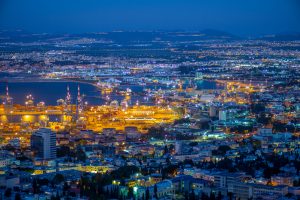
Haifa is a city with an ancient and fascinating history. It is indeed one of the most remarkable and charming places of Israel besides being the third biggest city of this beautiful country after Jerusalem and Tel Aviv. The population of Haifa is very heterogeneous because even though the majority of the residents is Jewish, consisting 82% of the entire population, 14% consists of Christians and 4% of Muslims. In Haifa, there are also Druze and Bahá’í Faith communities. Additionally, Haifa is the immigration centre of newcomers from the former Soviet Union. There is also a Scandinavian Seamen Protestant church that Norwegian Righteous Among the Nations pastor Per Faye-Hansen established.

Moreover, Haifa is the centre of liberal Arabic-speaking culture, and in the 21st century, Arab cultural life became active. The Arabic-speaking neighbourhoods, where Muslims and Christians live together, are in the valleys near the sea, while Jewish live in higher areas.
Haifa is located on the Israeli Mediterranean Coastal Plain, the historic land bridge between Africa, Asia, Europe, and the Kishon River’s estuary. The city lies on the northern slopes of Mount Carmel, around Haifa Bay, and it is split into three levels, of which the lower consists of the business and industrial centre, including the Port of Haifa. The middle level is located on the slopes of Mount Carmel, and it consists of old residential neighbourhoods, while the upper level comprehends modern neighbourhoods. From the upper level, there is a fantastic landscape of the Western Galilee area of Israel close to Rosh HaNikra and the Lebanese border. Haifa is 90 kilometres from Tel Aviv, and it hosts several beautiful beaches on the Mediterranean sea.
The Mount Carmel area includes three types of wadis: valleys, oases, or stream beds that are wet only during the rainy season. The three wadis in Mount Carmel reserve are Lotem, Amik and Si’ach. In most parts of these valleys, natural corridors cross the city from the coast to the top of the mountain. This area hosts many hiking paths that are a natural habitat for wildlife, such as chameleons, Egyptian mongooses, golden jackals, hyraxes, owls and wild boars.
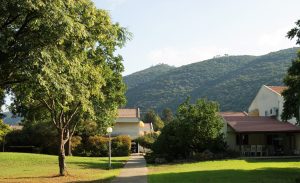
Haifa has typical Mediterranean weather with hot and dry summers and rainy winters. The springs start in March, and in late May, the temperature rises with an average temperature of 26 °C, and in winter, the medium temperature value is 12 °C. In Haifa, snows are rare even though the temperature can drop to 3 °C. Haifa is a humid city, and rains fall from September until May, with an annual precipitation level of 629 millimetres.
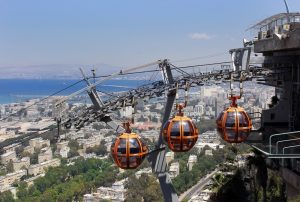
Haifa is structured in three levels, and the oldest neighbourhood in modern Haifa is Wadi Salib, which is the Old City centre near the port, halved by the main road and including government buildings. Nowadays, Wadi Salib spreads over until Wadi Nisnas, the Arab centre in Haifa. In the 19th century, the Ottomans built the German Colony, contributing to Haifa’s first urban development. Recently, some buildings have been renovated, and the colony became a centre of Haifa nightlife. At the beginning of the 20th century, the first buildings were built in Hadar, which was Haifa’s business and cultural centre from the 1920s until the 1980s. Hadar extends from the bay area at mid-height of Mount Carmel, nearby the neighbourhoods of German Colony, Wadi Nisnas and Wadi Salib. In Hadar, two malls are enclosed by some of the city’s older neighbourhoods. Another historical neighbourhood is Neve Sha’anan, which lies on the second layer of Mount Carmel, and it was founded in the 1920s. Popular neighbourhoods among English speakers are Ahuzza, Neve Shaanan and Upper Hadar. A distinctly different lifestyle features each suburb.
Haifa’s famous tourist landmark is the Baháʼí World Centre, with the golden-domed Shrine of the Báb and the beautiful gardens. In 2008, the Baháʼí gardens were appointed a UNESCO World Heritage Site. Other Haifa landmarks are the renewed German Colony, established by the Templars, Stella Maris and Elijah’s Cave. In the Ein Hod artists’ colony, there are over 90 artists’ and artisans’ studios and exhibitions. Another exciting place to visit in Haifa is the Mount Carmel national park, with its caves where archaeologists have found Neanderthal and early Homo Sapiens relics. Indeed, Haifa is the cultural heart of northern Israel. During the 1950s, mayor Abba Hushi encouraged authors and poets to move to the city and founded the Haifa Theatre, the first municipal theatre established in the country. The leading Arabic theatre among the northern Arab population is the al-Midan Theater. Other theatres are the Rappaport Art and Culture Center and the Krieger Centre for the Performing Arts. In the Congress Center, there are usually concerts, exhibitions, and special events.
The New Haifa Symphony Orchestra was founded in 1950, and now it counts more than 5,000 subscribers. Another important institution of Haifa is the Haifa Cinematheque, founded in 1975, which hosts the annual Haifa International Film Festival throughout the Sukkot holiday. Haifa has 29 movie theatres, and it owns a local newspaper, Yediot Haifa, and its radio station, Radio Haifa.
Haifa holds more than a dozen museums. The most famous museum is the Israel National Museum of Science, Technology, and Space, located in the historic Technion building in the Hadar neighbourhood. Another important museum is the Haifa Museum of Art that is home to a collection of modern, classical art and images about the history of Haifa. One of the most peculiar landmarks is the Tikotin Museum of Japanese Art, the only museum in the Middle East devoted entirely to Japanese art. Haifa’s other museums are the Museum of Prehistory, the National Maritime Museum, the Haifa City Museum, the Naval Museum, and the Israeli Oil Industry Museum. Close to Haifa, the Northern “Hai-Bar” is managed by Israel’s Parks and Reserves Authority to breed and reintroduce extinct species such as Persian Fallow Deer.

Hence, as you read, the history of Haifa is pretty various and interesting as the other cities of Israel. A very ancient city with many aspects and places to visit that cannot be missed in your vacation itinerary.


